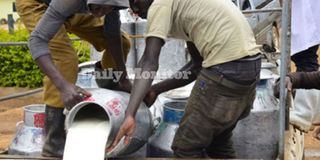Add value to your milk

Farm workers prepare milk for supply. PHOTO/FILE/RACHEL MABALA.
In a protest letter to Kenya, Uganda last month threatened to reconsider her position on the East African Community Customs Union Protocol and impose retaliatory taxes after Kenya seized its milk.
As leaders get to the boardrooms to solve the trade impasse, our farmers need to take advantage of the locally increased consumption of dairy products such as yoghurt and cheese.
Farmers who have milk surpluses can seize the opportunity to capture the market with high quality, handmade cheese.
There is only a handful of artisan cheese makers in Uganda but the market potential invites more farmstead producers—those who only work with milk from their own animals.
Making cheese
Value addition to milk doubles the price, although other materials used in the process cost 40 per cent of the price of the product.
Among the ingredients needed for professional cheese making are potassium nitrate, starter culture, rennet, wax and colour.
Potassium nitrate is added to improve the keeping quality, while the starter culture is used for the introduction of bacteria, whose main purpose is acid production.
During the ripening process, the bacteria play other essential roles by producing volatile flavour compounds (like diacetyl, aldehydes), by releasing enzymes involved in cheese ripening.
Besides, they produce natural antibiotic substances that suppress growth of pathogens and other spoilage microorganism.
Rennet is a natural complex of enzymes that coagulates (solidifies) the milk, separating it into the solid curd and liquid whey.
Cheese-making happens in seven main stages; acidification, coagulation, cutting, salting, shapin and ripening.
By Charles Tabu




